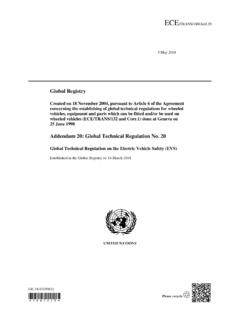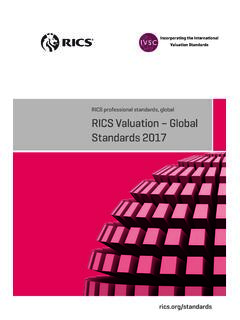Transcription of Sustainable Finance Disclosure Regulation - Deloitte
1 Sustainable Finance Disclosure RegulationIs the financial industry ready for the Big One? An international overviewContentIntroduction 3 Methodology 6 Disclosure and definitions 8 Questions and answers 12 to 28 Where are we ? 30 Conclusion 3123 Climate change is considered to be one of the most significant threats to financial stability. According to the World Economic Forum (WEF), the cost of natural disasters worldwide was USD165 billion in 2018, more than the gross domestic product (GDP) of Hungary in 2018 (EUR157 billion).
2 Introduction 1. ( )2. Climate Bonds Initiative (CBI) global Sustainable Debt report: H1 2020 review of green, social, sustainability & pandemic markets3. Articles 8 and 9 of the Regulation (EU) 2019/2088 of the European Parliament and of the Council of 27 November 2019 on sustainability related disclosures in the financial services sectorA National Climate Assessment study forecasted that climate-related natural disasters will reach 10 percent of the global GDP by the end of the century1. The debt market has kept up its sustainability efforts, even amid the COVID-19 crisis, and the latest outlook and direction reports from the Climate Bonds Initiative (CBI) for the past 12 months have reported that, overall, the performance of the combined Sustainable debt market (green, social, sustainability, etc.)
3 Was very strong in H1 2020, with over USD250 billion issued compared to USD341 billion for 20192. The financial sector must take swift action to preserve its stability and limit damages caused by climate change. A series of recent regulations indicate that European regulators will use the financial sector to build and Finance a low carbon economy. These include the European Union (EU) Taxonomy to define a common sustainability narrative for investors; the integration of sustainability preferences into the Markets in Financial Instruments Directive (MiFID, Directive 2014/65/EU); and the revision of the EU Non-Financial Reporting Directive (NFRD, Directive 2014/95/EU)3. 44. Article 4 of the Regulation (EU) 2019/2088 of the European Parliament and of the Council of 27 November 2019 on sustainability related disclosures in the financial services sectorOf these recent regulations , the Sustainability Related Financial Disclosure Regulation (SFDR) is the closest to being applied and will require Financial Market Participants (FMPs) and financial advisors to evaluate and disclose sustainability-related data and policies at entity, service and product level.
4 This is to prevent greenwashing and ensure a systematic, transparent and comparable approach to sustainability within financial markets. Although FMPs are working against the clock to get ready to meet the requirements of the Sustainable Finance regulatory framework , some players are also actively negotiating with supervisors and regulators to defer the application of the Regulatory Technical Standards (RTS) on sustainability-related disclosures. Many financial debates of the past few months have highlighted serious concerns that the SFDR s target population may not be adequately prepared to address these changes. Some of the current timelines are rather tight or even unachievable; by 10 March 2021 (less than six months from now), the majority of the SFDR provisions are supposed to take effect.
5 Another major obstacle is the lack of finalized guidelines. The European Supervisory Authorities (ESAs) have until the end of the year to submit precise templates; meaning that, until then, the target population will have to base their disclosures on a principle-level and a best-efforts basis. Though this is generally still feasible, it leaves a lot of unanswered questions around product Disclosure and compliance with principal adverse financial debates of the past few months have highlighted serious concerns that the SFDR s target population may not be adequately prepared to address these changes. 5On the 23rd of April the European Supervisory Authorities have issued a consultation paper setting out a proposal for Regulatory Technical Standards (RTS) providing details on content, methodologies and presentation of disclosures under the SFDR.
6 Comments were invited on all aspects of the consultation to get a sense of how the industry was already performing on these issues and what were common practices identified. It is in this context that we issued this survey, which is primarily aimed at taking the temperature of FMPs regarding their understanding, perception and level of preparedness regarding the major changes foreseen by the SFDR directive. We wanted to know FMPs opinion of the best way forward, taking into account the many layers of complexities involved; to assess their main concerns regarding Environmental, Social and Governance (ESG) data; to evaluate the integration of level I and level II; and to find out which role they think national competent authorities (NCAs) should play in the SFDR implementation.
7 56 Methodology RESPONDENTSA sset management59%Banks26%Financial advisory11%Insurance4%We surveyed the players in the scope of the SFDR, namely asset managers, bankers, financial advisors and insurers. Professionals from 21 countries responded to the eight-questions America4%Switzerland2%Non-EU 31%US2%The responses encompass a representative panel of market concerns. The survey aimed to include a range of international responses, given the pressure felt by firms not headquartered in Europe but still in the scope of the SFDR due to the distribution aspect of their activities. Therefore, while European respondents are the most represented, we also obtained numerous responses outside of Europe, particularly from Asia. Some of the issues we focused on include: The link between expected sustainability risk disclosures and the EU taxonomy (if it is perceived as realistic, concerns around the lack of unanimity of taxonomy definitions, etc.)
8 The need to strike the right balance between reporting and accountability The relationship/alignment with current rating protocols and existing frameworks The level of readiness of NCAs The future evolution of indicatorsCollecting these perspectives also provided a picture of FMPs current level of knowledge, prompting recommendations on how to increase awareness of the SFDR and develop a stronger inter-stakeholder dialogue to help smooth its entry into force. 8 Sustainable investments are deemed to be products that promote sustainability or achieve a Sustainable objective. There has never been one accepted definition for a Sustainable product, either Europe-wide or globally; however, some players have attempted to propose definitions5. A rather comprehensive definition proposed at European level, has been an important source from which the European Commission could start drafting its blueprint of a Sustainable Finance strategy and first action plan, this was: Sustainable and Responsible Investment (SRI) is a long-term oriented investment approach, which integrates ESG factors in the research, analysis and selection process of securities within an investment portfolio.
9 It combines fundamental analysis and engagement with an evaluation of ESG factors in order to better capture long term returns for investors, and to benefit society by influencing the behavior of companies. 6In parallel, industry players have added their own understanding and considerations that have further increased the level of complexity, especially when measuring the impact of these investments. As stated in the ESAs consultation document, negotiations were on-going on the draft taxonomy Regulation while Article 2(17) SFDR defined Sustainable investments without reference to the taxonomy Regulation . These negotiations, which determined the proposal of the text rather than focusing on a set definition, used only a series of taxonomy components that were the main elements of this reference framework.
10 In particular, the SFDR refers to specific types of disclosures for different types of product categories that, according to articles 8 and 9, require additional pre-contractual and definitions5. Mostly industry-led associations (Eurosif, GSIA, PRI) and financial players9 Disclosure requirements apply under article 8 to products that promote also environmental or social characteristics, whereas Disclosure requirements apply under article 9 to products that have Sustainable investment as their objective. This forces asset managers to determine whether their products come under the scope of either article 8 or article 9 at a very early stage of their implementation project. The SFDR does not prescribe how FMPs should determine to which category their products belong, but it does provide key elements that can be considered when making these evaluations regarding marketing communications or mandatory investor disclosures.














